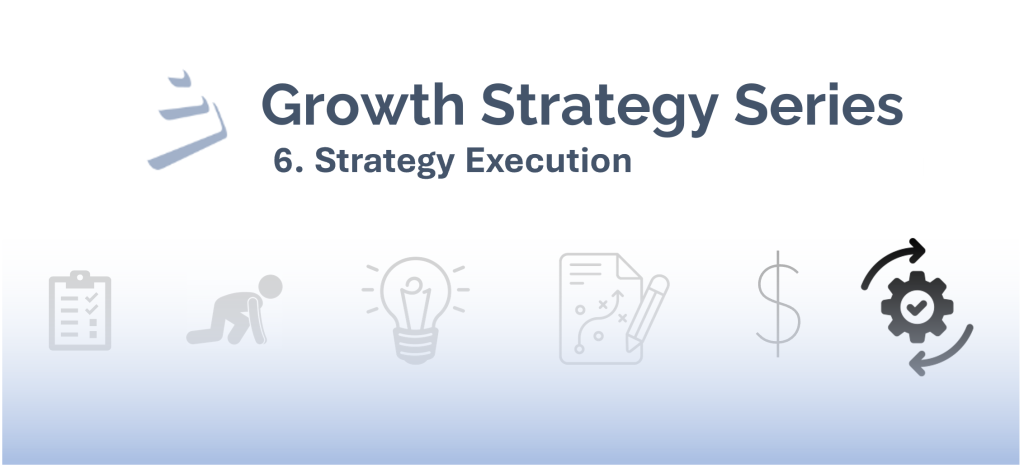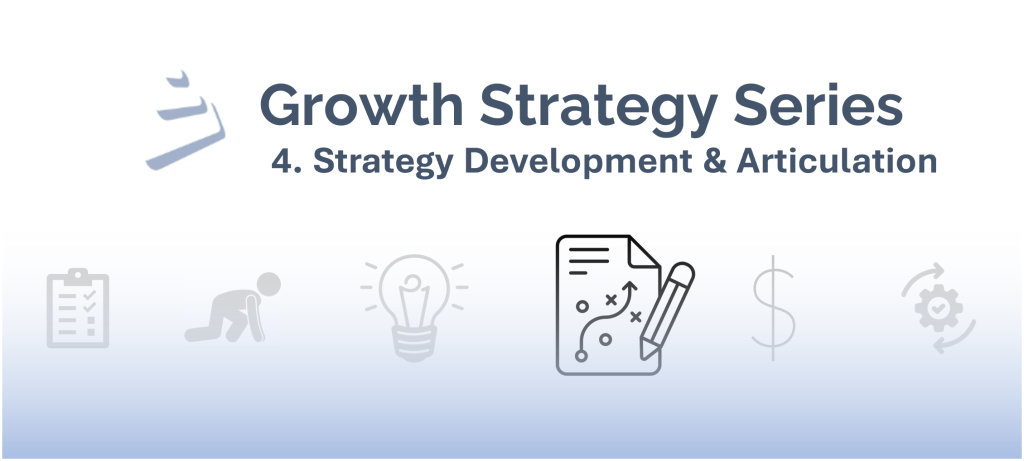Chapter 3 Recap
Welcome back to the growth strategy series. In our last chapter, we discussed the insights generation phase of growth strategy development. Key takeaways are as follows:
- Insights are not findings and observations. They are the result of careful analysis and often a combination and synthesis of various facts and data points.
- The insights generated via the market, customer, and competitive assessments, along with business performance analysis, will ultimately form the foundational knowledge and single source of truth upon which you will build your strategy.
- For best results, be open to change, internalize the impact of your assumptions, develop repeatable and scalable processes and tools, and save tactical discussions for later in the strategic process.
In this chapter, we will outline the strategy development process, including how to synthesize your raw insights in order to articulate your strategy. This portion of the strategy development process comes with new terminology for many, so let’s define a few key concepts before we begin:
- Insight: A deep and unique understanding of something that provides the basis from which to make strategic choices and is often a competitive advantage.
- Implication: What an insight means for the business and how it might be addressed or leveraged as part of strategy development.
- Brutal Truth: An internal or external insight that will have significant consequences for the business if not addressed.
- Purpose: A company’s reason to exist. Purpose statements are meant to be concise, memorable, and represent a call-to-action.
- Vision: The company’s aspirations. Vision statements commonly begin with “We aspire to be…” and often highlight the main drivers of differentiation the company hopes to achieve.
- Financial Objective: A quantifiable financial outcome the company aspires to achieve within the strategy timeframe; the most common metrics are revenue and EBITDA.
- Strategic Imperative: The critical choices the organization will make to achieve the purpose, vision, and financial objectives (also known as strategic pillars).
- Initiative: The tactical actions the company must undertake to deliver each imperative. Initiatives should be aligned to the imperative, actionable, quantifiable, time bound. (to be covered in more detail in the next chapter)
- Key Enabler: The capabilities, differentiators, internal processes, mindsets, and behaviors that help to drive success across ALL strategic imperatives.
Chapter 4: Strategy Development & Articulation
Team Composition & Key Activities
Armed with an informed and aligned group of key decision-makers coming out of the insights generation phase, the process shifts to synthesizing your findings to set the foundation of your strategy and craft a unique pathway to growth. In the strategy development and articulation phase, you should expand beyond your core insights generation workstream teams to include more stakeholders in the conversation, such as product line managers, marketers, and salespeople, to make integrated business decisions.
Through collaborative working sessions, the expanded team pares down the information gathered during insights generation into key insights and implications, brutal truths, a company vision and purpose, prioritized growth opportunities, and strategic imperatives. This phase also includes an approximate value potential for key strategic imperatives to build a “top-down” strategy quantification.
Choices coming out of these sessions are preliminary and amenable to change; however, they should still capture the essence of your strategic vision.
Insights, Implications, & Brutal Truths
The first step of strategy articulation is translating the findings from the insights generation phase into key insights, implications, and brutal truths that drive strategic decision-making and create competitive advantage. Insights generation results in substantial insights on market, competitive, customer, and business performance, so the challenge is filtering out the most critical insights, understanding their strategic implications, and aligning on brutal truths (i.e., internal or external insights that will have significant consequences for the business if not addressed).
We typically ask client core teams to set aside at least a day of in-person workshop time to discuss insights and brutal truths. We encourage all team members to speak candidly about their views on the business, take a hard look in the mirror with respect to where the company succeeds and where it does not, and pressure test currently accepted truths. Insights and brutal truths sessions are open and challenging, but they are critical to developing a meaningful strategy. Your strategy suffers if you focus on what you want to hear instead of what the data and your team are telling you to be the case.
At the end of the workshop, the team should have an aligned and summarized list of the most relevant insights, their implications, and brutal truths that the strategy will then need to address.

Strategy Articulation
With synthesized insights and brutal truths in hand, your team transitions to building the fundamentals of your growth strategy through workshops to define your purpose, vision, financial objectives, core values, company evolution, strategic imperatives, and key enablers. As with insights, implications, and brutal truths, it is critical that strategy development workshops are held in-person. There is no replicating the level of engagement that comes from face-to-face interaction, and for conversations that define the future for your organization, the investment in time and money to get key stakeholders in the same room is well worth it. We also recommend unconstrained forward-thinking at this stage; do not limit yourself by thinking within the strict boundaries of your business today.
Strategy development workshops typically start with purpose, vision, financial objectives, core values, and company evolution, which determine who you are, what you want to be, and what you plan to change.
- Purpose: As defined above, purpose states a company’s reason to exist. Challenge yourself to think beyond what you do, or what you make. Ford manufactures vehicles, but their purpose is “to drive human progress through freedom of movement.”
- Vision: A company’s aspirations. Vision statements go beyond quantification and define how your company will exist in the hearts and minds of your customers and consumers, and the differentiating characteristics that support that position.
- Financial Objectives: The quantifiable financial outcome you hope to achieve within the strategy timeframe. Financial objectives should be challenging to achieve, extending beyond maintaining historical growth.
- Core Values: The principles and standards of behavior that you want your people and company to live by.
- Company Evolution: Characterizing where your company is today, and where you need to be to deliver the strategy. For example, siloed culture à unified, integrated organization.
The purpose, vision, financial objectives, core values, and company evolution provide the foundation for the remainder of your strategy development workshops, which is dedicated to defining the core elements of your strategic plan: imperatives and enablers.
- Strategic Imperatives: Defined as the critical strategic choices your organization will make to achieve the strategy (we typically see 4 to 6 strategic imperatives – try not to over-extend your organization with too many imperatives). These choices could be to target specific end-markets or customer groups, emphasize and innovate certain products or services, improve profitability in certain areas of the business, redefine the company culture, build commercial excellence, and more. Strategic choice discussions should start broad to capture all potential ideas (including what to do and what not to do) and then narrow as potential imperatives are evaluated against insights, brutal truths, and company ambitions to ensure they address the most pressing areas. Most importantly, strategic imperatives should be tailored to your company’s unique path to growth.
- Key Enablers: Enablers drive success across all imperatives. Enablers could center around process improvement and standardization, enhanced communication and collaboration across the enterprise, or data and analytics capability. There is interplay between imperatives and enablers, and we typically see organizations spend considerable time aligning on whether certain strategic focus areas fall under imperatives or enablers. A general rule of thumb we like to use is that imperatives have a Revenue and EBITDA impact tied to them. Enablers may require investment, but that investment supports the imperatives that drive Revenue and EBITDA.
See below for a sample “strategy on a page” framework – the target output of the strategy development and articulation process.

Takeaways and What’s Next
- The growth strategy development stage establishes concise vision and purpose, core values and competencies, and financial objectives.
- Data-backed insights, implications, and brutal truths drive strategic decision-making and create competitive advantage.
- Imperatives and enablers build on insights, implications, and brutal truths by identifying the key strategic choices that need to be made and what supports them.
- Strategy development sessions are highly collaborative and best held in person. We recommend keeping an open mind and thinking unconstrained.
In our next chapter, we discuss the final step of strategy development, which consists of identifying and quantifying the tactical initiatives to deliver the strategy. For questions about this piece, coming installments, or how we can help at any stage of strategy development, contact Mike Gill, Senior Consultant, or Pieter Rhynhart, Associate Consultant, at Denneen & Company.
Denneen & Company is a growth strategy consulting firm that has been helping companies find and follow their unique paths to growth for over 28 years. With experience across 20+ industries, 40+ consumer categories, and 40+ countries, Denneen & Company consultants leverage their former backgrounds as industry practitioners and past engagements to develop practical and achievable strategies based on rigorous analysis, breakthrough insights, and a collaborative approach. To learn more, please visit denneen.com.



